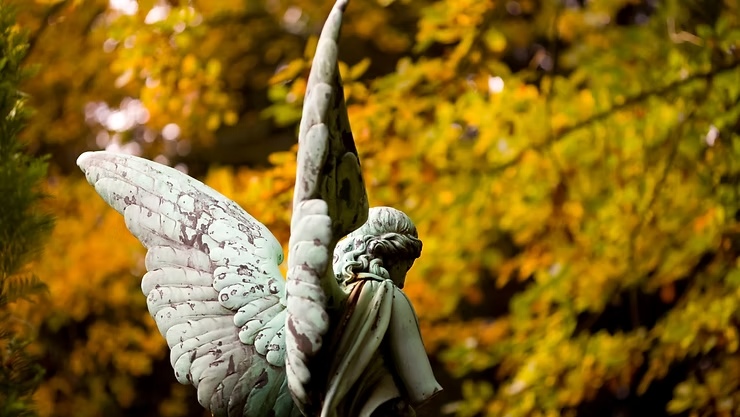Cherubim and Seraphim: Heavenly Beings in the Bible
Guardians of God’s Glory
Cherubim and seraphim serve as the ultimate guardians of God’s glory, embodying divine sanctity and majesty. They symbolize God’s holiness and act as protectors who ensure His presence remains revered and pure.
Cherubim call for humility and reverence, reflecting God’s protective nature, while seraphim model ceaseless worship and adoration, encouraging believers to exalt God’s greatness.
The Garden of Eden
The Bible first introduces cherubim as divine guardians placed at Eden’s entrance after Adam and Eve’s fall, preventing access to the Tree of Life. They wield a flaming sword, emphasizing their role as protectors of sacred spaces (Genesis 3:24).
Characteristics and Depictions
Cherubim and seraphim are often depicted with wings and mixed human-animal features. Ezekiel’s vision describes cherubim with four faces—a man, lion, ox, and eagle—symbolizing creation’s diversity. Their wings touch, emphasizing unity and purpose.
Roles and Symbolism
- Cherubim: Guardians of God’s sacred spaces, symbols of wisdom and protection.
- Seraphim: The “burning ones,” representing purification and unending worship near God’s presence.
Together, they reflect the balance of God’s immanence and transcendence, guiding spiritual understanding.
Fiery Ones Who Worship God
Seraphim embody God’s consuming holiness, ceaselessly praising with cries of “Holy, holy, holy” (Isaiah 6:3). Their six wings cover their faces and feet, highlighting reverence and humility in worship.
Significance in Christian Faith
Cherubim and seraphim symbolize reverence for God’s holiness, bridging heaven and earth. Cherubim protect sacred spaces, while seraphim embody God’s purifying and transforming presence.
Cherubim and Seraphim: Divine Messengers and Guardians
Protectors of God’s Presence
They surround God’s throne, ensuring only the worthy approach. Cherubim symbolize reverence; seraphim represent eternal worship, inspiring believers to honor God’s greatness.
Symbolism of Holiness
- Guardianship of the divine
- Unceasing adoration
- Inspiration for believers
Their holiness influences Christian rituals, art, and theology, emphasizing God’s sanctity.
Adoration and Worship
Cherubim and seraphim exemplify ceaseless glorification. Cherubim evoke humility before God’s sanctity, while seraphim reflect passionate praise and worship, serving as models for believers.
Interactions with Humanity
These beings influence morality, culture, and personal behavior. They are seen as guides for ethical decisions, shaping spiritual and social governance throughout history.
Cherubim and Seraphim: Mystical Entities in Christian Theology
Celestial Beings in Art
Artists from the Renaissance to modern times portray cherubim and seraphim as majestic, often winged figures, reflecting their divine and mystical nature.
Throne Bearers of the Deity
They are depicted as bearers of God’s throne, symbolizing their proximity to and role in upholding divine sovereignty and majesty.
Symbolic Representations
Beyond literal biblical roles, they symbolize spiritual purity, divine presence, and the human moral struggle, encouraging believers toward spiritual enlightenment and integrity.
Connection to Divine Will
Cherubim and seraphim act as conduits of God’s will, linking prayer, rituals, and sacred symbols to divine intentions, fostering harmony between heaven and earth.
Understanding Their Roles and Significance
In Biblical Narratives
These beings actively participate in the cosmic struggle between good and evil, guarding God’s glory and executing His will throughout scripture.
In Christian Iconography
Cherubim’s multiple wings and faces emphasize omnipresence and guardianship, while seraphim’s six wings and fiery nature highlight worship and holiness in art.
In Religious Interpretations
Their roles evolve from literal guardians to symbols of spiritual journeys, reflecting modern challenges and internal moral battles.
In Contemporary Beliefs
Cherubim and seraphim serve as allegories for virtues and vices, bridging ancient scripture with today’s spiritual and existential concerns.
Conclusion
Cherubim and seraphim remain profound symbols of God’s holiness, majesty, and protective presence. As guardians and worshipers, they inspire reverence and ceaseless praise, enriching faith through biblical, artistic, and theological traditions.
Frequently Asked Questions
What are Cherubim and Seraphim and their significance in the Bible?
They are heavenly beings serving as guardians of God’s glory and symbols of His power, majesty, and worship.
What are the characteristics and depictions of Cherubim and Seraphim?
Cherubim have multiple faces and animal traits, while seraphim are fiery beings with six wings, portrayed as awe-inspiring.
What roles do Cherubim and Seraphim play in Christian theology?
They symbolize God’s holiness and majesty, acting as divine guardians and worshipers, bridging heaven and earth.
How are Cherubim and Seraphim depicted in art and religious interpretations?
They appear as winged, often multi-faced beings, embodying divine mysteries and inspiring reverence in Christian art.
What is the significance of Cherubim and Seraphim in contemporary beliefs?
They symbolize God’s presence, protection, and worship, inspiring spiritual guidance in modern faith journeys.
How do Cherubim and Seraphim interact with humanity?
They serve as divine messengers and guardians influencing morality, culture, and personal spiritual growth.
What is the symbolism of Cherubim and Seraphim in Christian iconography?
Cherubim symbolize protection and God’s omnipresence; seraphim represent fiery worship and holiness.
Why are Cherubim and Seraphim considered mystical entities in Christian theology?
Because of their supernatural traits and roles in divine mysteries, they transcend earthly limits and inspire awe.

